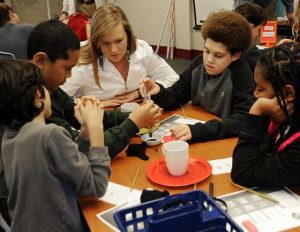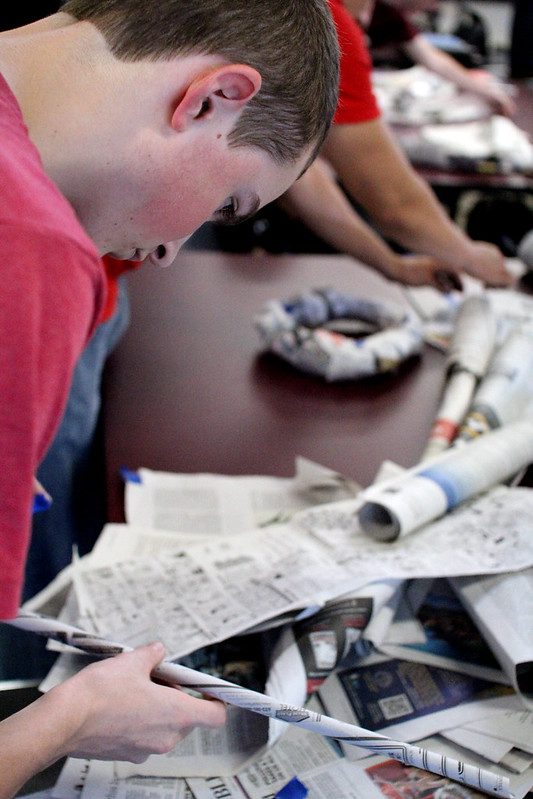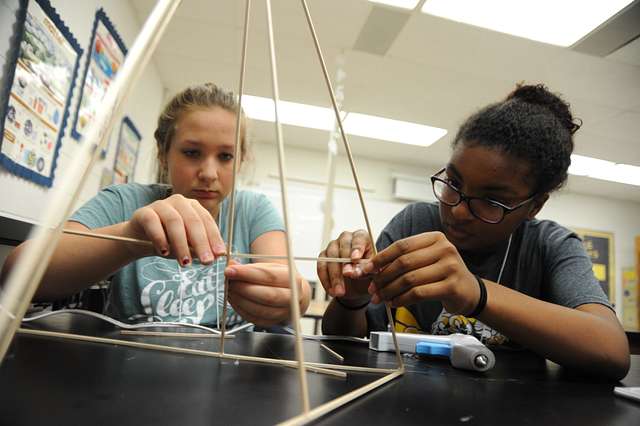Middle school is a crucial time to engage a diverse set of learners in STEAM education. And linked below are five of the best, free STEAM lessons we recommend to meet your various middle school needs.

It is true that STEAM lessons can seem like a big ask for teachers when operating within school limitations like time and resources, or concerns about a classroom cleanup. So we’ve curated STEAM activities for middle school that require few supplies, can be done in less than 20 minutes, and have little mess. Take a look and download your perfect STEAM activity for grade 6, grade 7, and grade 8!
STEAM Activity for Middle School #1 – Lesson with Fewer than 5 Supplies
Primary Content Covered: Geometry, Engineering (construct and solve a design problem)
 Newspaper Tower: When it comes to STEAM lessons, there are times when less is more. Building a newspaper tower is a tried-and-true way to integrate higher-order thinking in the classroom, with students being given a problem, supplies, and freedom to find the solution in their own way. The goal for each group in this lesson from Teach Engineering is for their tower to be the tallest, most stable, and best able to withstand “wind” (blowing on the tower to mimic a hurricane). Art can be incorporated into the activity by having students decorate the outside of their building with markers, colored pencils, or paint. This has students consider how visual appeal can impact and should be factored into engineering decisions. For example, the paint can add weight to the newspaper, making the top layers harder to support, or the markers may make the newspaper damp, causing the tower to be less structurally sound. With just four or five supplies, students are pushed to think beyond a textbook, and to develop confidence as scholars.
Newspaper Tower: When it comes to STEAM lessons, there are times when less is more. Building a newspaper tower is a tried-and-true way to integrate higher-order thinking in the classroom, with students being given a problem, supplies, and freedom to find the solution in their own way. The goal for each group in this lesson from Teach Engineering is for their tower to be the tallest, most stable, and best able to withstand “wind” (blowing on the tower to mimic a hurricane). Art can be incorporated into the activity by having students decorate the outside of their building with markers, colored pencils, or paint. This has students consider how visual appeal can impact and should be factored into engineering decisions. For example, the paint can add weight to the newspaper, making the top layers harder to support, or the markers may make the newspaper damp, causing the tower to be less structurally sound. With just four or five supplies, students are pushed to think beyond a textbook, and to develop confidence as scholars.
STEAM Activity for Middle School #2 – Lesson Under 20 Minutes
Primary Content Covered: Chemistry (temperature, chemical reactions, molecules)
Alka-Seltzer Powered Lava Lamp: STEAM projects don’t have to be time consuming. A quick, 20-minute lab added to an existing lesson can add variety to the way information is presented and ensure an objective is mastered by as many students as possible. Being invisible to the naked eye, chemical reactions, molecules, and temperature can be difficult for learners to conceptualize. This Science Buddies lesson creating alka-seltzer powered lava lamps makes the subject matter come to life, rather than relying on imaginations or videos. Students can also get practice with color theory, being provided with only the three primary colors for their lava lamps and using those to create their desired color. The addition of a lab such as this is an easy, safe way to reach all types of learners.
STEAM Activity for Middle School #3 – Lesson Simulating Real-World Problems
Primary Content Covered: Environmental Science, Engineering
Like Oil and Water: Topics such as climate change can be daunting to tackle. There is a lot of necessary but negative information to cover that can overwhelm students as they come to recognize hard truths about the world around them. Using Population Education’s STEAM focused lesson, Like Oil and Water, can provide an opportunity to shift towards a solution-oriented mindset. Using engineering and design skills, the lesson simulates an oil spill and has learners problem-solve by creating and testing their own clean-up strategies. Initial sketches of their strategy have students practice scale and proportions in art compositions. Allowing students to see that the knowledge they already possess can make a difference in bettering the planet helps inspire action and hope in students that can translate into their daily lives.
STEAM Activity for Middle School #4 – Lesson with Easy Clean-up
Primary Content Covered: Physics (relationship between mass and distance)
Mini Rockets: An easy clean-up lesson is perfect for the beginning of the year when classroom expectations are being established. Mini Rockets from Nasco Education has learners applying knowledge of physics to see how the mass of an object impacts the distance traveled. Students can make their own unique rockets by drawing designs directly on their project, or can further test the impact of mass on distance traveled by adding stickers or string to their rockets. This lesson requires minimal movement from students, making it an accessible, hands-on project that won’t disrupt your classroom organization.
STEAM Activity for Middle School #5 – Lesson Using Art to Develop a Math Skill
Primary Content Covered: Geometry, Design
Mandalas, Polygons, and Symmetry: Using a STEAM lesson as a method for skill mastery is a creative way to help cement learning in the memory of students. This lesson from the Kennedy Center can help students who are not yet comfortable using a compass to practice manipulating the tool before utilizing the skill regularly in class. In Mandalas, Polygons, and Symmetry, students apply knowledge of art composition and geometry to create their own unique patterns in mandalas. The activity has the added bonus of including social studies learning by providing resources on the history and significance of mandalas, as well as providing recommended modifications for individuals with low/blind vision.
Why Teach STEAM in Middle School?
 Allowing middle schoolers to express themselves within the structure of STEAM lessons encourages curiosity and exploration beyond what may be provided in standard lesson materials and develops an independence in learning that is vital for success in high school. Bringing agency into learning can increase buy-in to topics that historically may have been perceived as boring or “too challenging” for some students. In the age of technology and social media this type of engagement is crucial to garnish and maintain interest.
Allowing middle schoolers to express themselves within the structure of STEAM lessons encourages curiosity and exploration beyond what may be provided in standard lesson materials and develops an independence in learning that is vital for success in high school. Bringing agency into learning can increase buy-in to topics that historically may have been perceived as boring or “too challenging” for some students. In the age of technology and social media this type of engagement is crucial to garnish and maintain interest.
With lessons like these, opportunities for innovation do not have to be a special occasion in the classroom. STEAM education grows independence in learners that improves their abilities to form and share original ideas. By employing this intersection of content learning in classrooms, we are better preparing students for real-world application of knowledge – having fun is just the cherry on top!
Image credit: Students in a group project (STARBASE Academies project by the Defense Visual Information Distribution Service is Public Domain); Newspaper Tower (ERG 101 Newspaper Tower Building by The Polytechnic School at ASU is licensed under CC BY-NC-SA 2.0); Balsa wood tower (US Navy-sponsored STEM Summer Academy by the Defense Visual Information Distribution Service is Public Domain)


